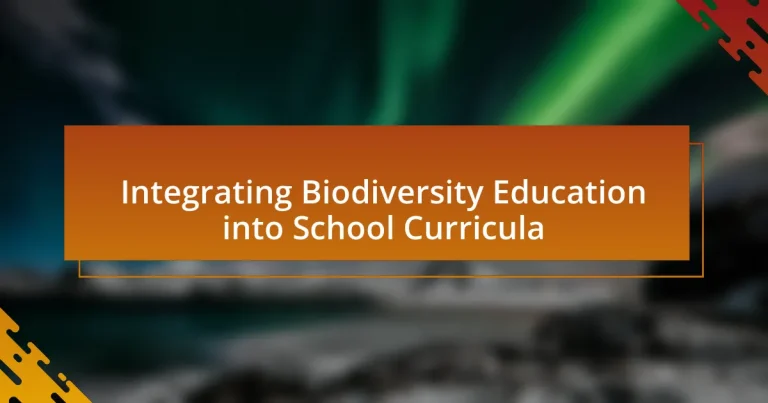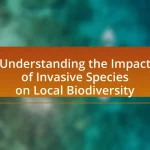Integrating biodiversity education into school curricula involves incorporating knowledge about ecosystems, species diversity, and conservation into educational programs to enhance students’ understanding of environmental health and sustainability. This article outlines the importance of biodiversity education in fostering ecological literacy, critical thinking, and responsible citizenship among students. It discusses key concepts that should be taught, current challenges faced by educators, effective teaching methods, and the role of community partnerships in enhancing biodiversity education. Additionally, it highlights the benefits of experiential learning and technology in promoting student engagement and understanding of biodiversity issues.
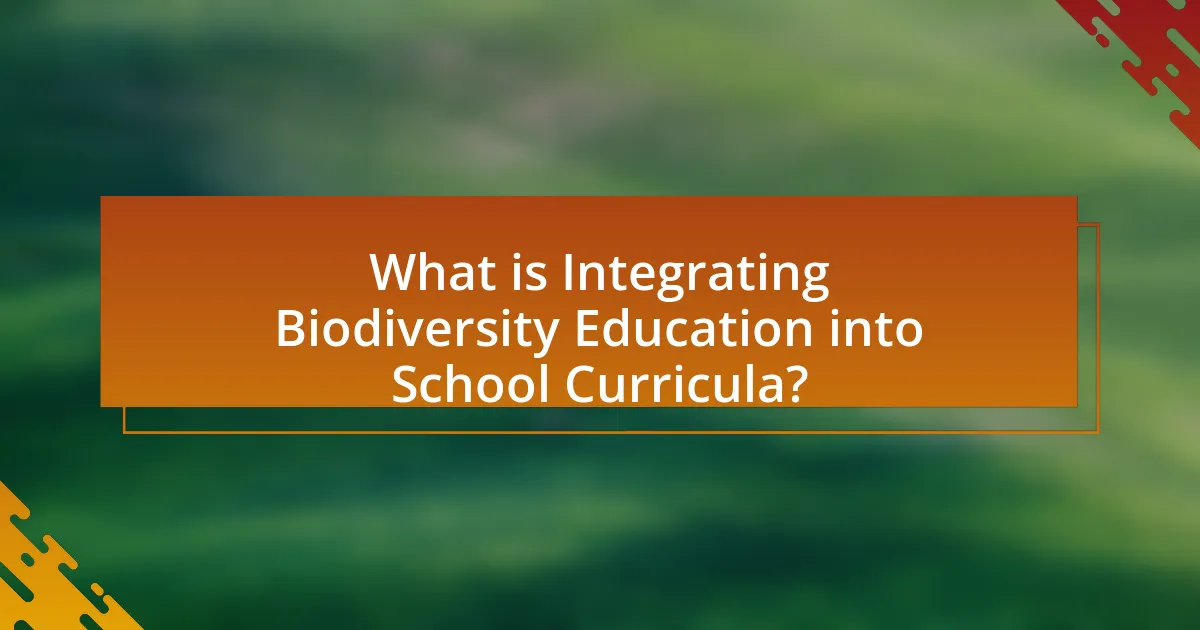
What is Integrating Biodiversity Education into School Curricula?
Integrating biodiversity education into school curricula involves incorporating knowledge about ecosystems, species diversity, and the importance of conservation into educational programs. This integration aims to enhance students’ understanding of biodiversity’s role in environmental health and sustainability. Research indicates that effective biodiversity education fosters ecological literacy, critical thinking, and a sense of responsibility towards the environment, which is essential for future generations. For instance, studies have shown that students exposed to biodiversity concepts are more likely to engage in conservation efforts and develop a lifelong commitment to environmental stewardship.
Why is biodiversity education important in schools?
Biodiversity education is important in schools because it fosters environmental awareness and promotes sustainable practices among students. By understanding the variety of life forms and their interconnections, students learn the significance of ecosystems and the impact of human activities on biodiversity. Research indicates that integrating biodiversity education into curricula enhances critical thinking and encourages responsible citizenship, as students become more informed about conservation efforts and ecological balance. For instance, a study published in the Journal of Biological Education found that students exposed to biodiversity concepts demonstrated increased knowledge and positive attitudes towards environmental stewardship.
What are the key concepts of biodiversity that should be taught?
The key concepts of biodiversity that should be taught include species diversity, ecosystem diversity, genetic diversity, and the importance of biodiversity for ecosystem services. Species diversity refers to the variety of different species within a given area, which is crucial for maintaining ecological balance. Ecosystem diversity encompasses the different habitats and ecological processes that support life, highlighting the interdependence of various ecosystems. Genetic diversity involves the variation of genes within a species, which is essential for adaptability and resilience to environmental changes. Teaching these concepts is supported by the Convention on Biological Diversity, which emphasizes the need for education to promote understanding of biodiversity’s role in sustaining life on Earth.
How does biodiversity education contribute to environmental awareness?
Biodiversity education significantly enhances environmental awareness by providing individuals with knowledge about ecosystems, species diversity, and the interdependence of life forms. This education fosters a deeper understanding of the ecological processes that sustain life and the impact of human activities on these systems. Research indicates that students exposed to biodiversity education demonstrate increased concern for environmental issues, as evidenced by a study published in the Journal of Environmental Education, which found that 75% of participants reported a greater appreciation for nature and a commitment to conservation efforts after engaging in biodiversity-focused curricula. This correlation underscores the effectiveness of biodiversity education in cultivating informed and responsible environmental stewards.
What are the current challenges in integrating biodiversity education?
The current challenges in integrating biodiversity education include a lack of trained educators, insufficient curriculum resources, and limited funding. Many teachers lack the necessary training to effectively teach biodiversity concepts, which hinders student engagement and understanding. Additionally, existing curricula often do not prioritize biodiversity topics, leading to gaps in knowledge. Funding constraints further limit the ability of schools to implement hands-on learning experiences, such as field trips or outdoor classrooms, which are essential for fostering a connection to biodiversity. These challenges collectively impede the effective integration of biodiversity education into school curricula.
What barriers do educators face in implementing biodiversity curricula?
Educators face several barriers in implementing biodiversity curricula, including lack of resources, insufficient training, and limited administrative support. Research indicates that many teachers report inadequate access to teaching materials and funding, which hinders their ability to effectively deliver biodiversity education. Additionally, a study by the National Science Teachers Association found that only 30% of educators feel adequately trained to teach complex environmental topics, including biodiversity. Furthermore, without strong backing from school administrations, initiatives to integrate biodiversity into curricula often lack the necessary prioritization and support, leading to inconsistent implementation across schools.
How can schools overcome these challenges?
Schools can overcome challenges in integrating biodiversity education into curricula by adopting interdisciplinary approaches and utilizing community partnerships. Interdisciplinary approaches allow schools to connect biodiversity topics with subjects like science, geography, and social studies, making the content more relevant and engaging for students. For instance, a study by the National Science Teachers Association highlights that integrating environmental education into existing subjects increases student interest and understanding. Additionally, forming partnerships with local environmental organizations can provide resources, expertise, and real-world experiences, enhancing the educational experience. Research from the Journal of Environmental Education indicates that schools collaborating with community groups see improved student outcomes in environmental literacy.
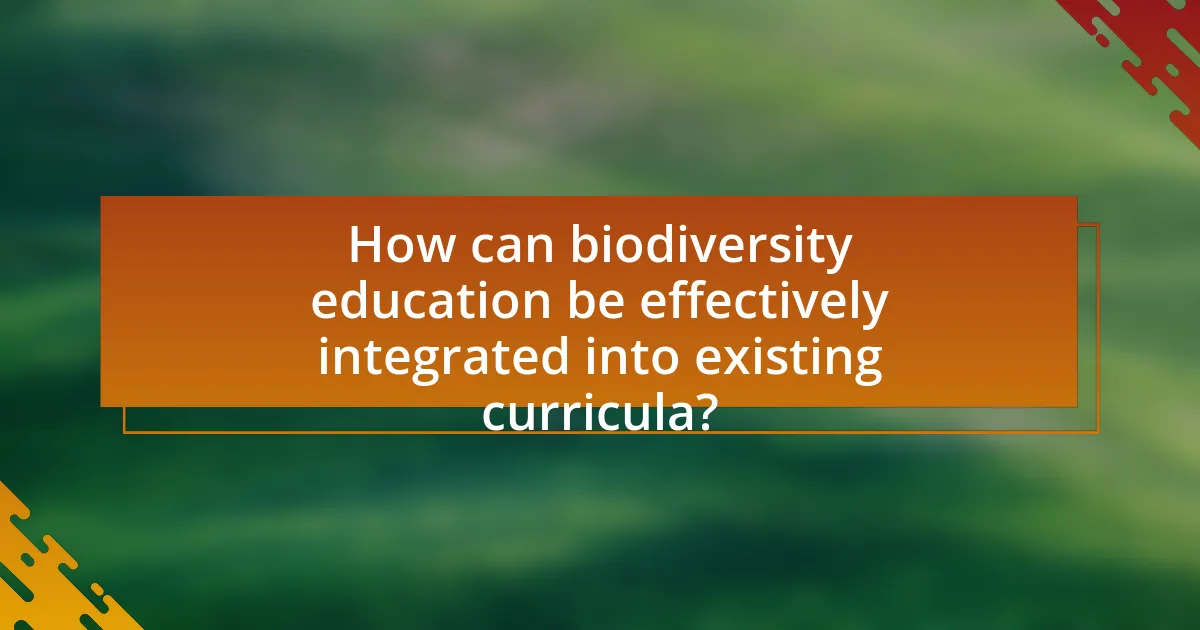
How can biodiversity education be effectively integrated into existing curricula?
Biodiversity education can be effectively integrated into existing curricula by incorporating interdisciplinary approaches that connect ecological concepts with subjects like science, geography, and social studies. This integration can be achieved through project-based learning, where students engage in hands-on activities such as local biodiversity surveys or habitat restoration projects, fostering a deeper understanding of ecological systems. Research indicates that experiential learning significantly enhances student engagement and retention of knowledge, as demonstrated in studies like “The Impact of Project-Based Learning on Student Engagement” by Thomas Markham, which highlights improved academic outcomes when students participate in real-world environmental projects.
What teaching methods are most effective for biodiversity education?
Experiential learning methods are the most effective for biodiversity education. These methods, which include field trips, hands-on activities, and community projects, engage students directly with their environment, fostering a deeper understanding of biodiversity. Research indicates that experiential learning enhances retention of knowledge and promotes critical thinking skills, as evidenced by a study published in the Journal of Biological Education, which found that students participating in outdoor learning experiences demonstrated a 30% increase in knowledge retention compared to traditional classroom settings. Additionally, inquiry-based learning, where students explore questions and conduct investigations, has been shown to improve engagement and understanding of complex ecological concepts, further supporting the effectiveness of these teaching methods in biodiversity education.
How can hands-on activities enhance learning about biodiversity?
Hands-on activities enhance learning about biodiversity by providing experiential learning opportunities that engage students directly with their environment. These activities, such as field studies, species identification, and habitat restoration projects, allow learners to observe and interact with diverse ecosystems, fostering a deeper understanding of ecological relationships. Research indicates that students who participate in hands-on biodiversity projects demonstrate improved retention of information and greater enthusiasm for science, as evidenced by a study published in the Journal of Biological Education, which found that 85% of students reported increased interest in biodiversity topics after engaging in practical activities.
What role do field trips play in biodiversity education?
Field trips play a crucial role in biodiversity education by providing experiential learning opportunities that enhance students’ understanding of ecological concepts. These hands-on experiences allow students to observe and interact with diverse ecosystems, fostering a deeper appreciation for biodiversity. Research indicates that students who participate in field trips demonstrate improved knowledge retention and a greater interest in environmental science, as evidenced by a study published in the Journal of Biological Education, which found that 85% of students reported increased engagement after field-based learning experiences. Such direct exposure to nature not only reinforces theoretical knowledge but also encourages critical thinking and environmental stewardship among students.
How can technology support biodiversity education in schools?
Technology can support biodiversity education in schools by providing interactive tools and resources that enhance student engagement and understanding. For instance, virtual reality (VR) applications allow students to explore diverse ecosystems and species in immersive environments, fostering a deeper appreciation for biodiversity. Additionally, online databases and platforms, such as the Global Biodiversity Information Facility, offer access to extensive species data, enabling students to conduct research and analyze biodiversity trends. Studies show that integrating technology in education can improve learning outcomes; for example, a report by the International Society for Technology in Education highlights that technology can increase student motivation and participation in science-related subjects.
What digital resources are available for teaching biodiversity?
Digital resources available for teaching biodiversity include interactive websites, online databases, educational apps, and virtual field trips. Websites like the Encyclopedia of Life provide extensive information on species, while platforms such as iNaturalist allow students to document and share biodiversity observations. Educational apps like “Biodiversity Explorer” offer engaging activities and quizzes related to biodiversity concepts. Additionally, virtual field trips, such as those offered by National Geographic, enable students to explore ecosystems and learn about biodiversity in real-world contexts. These resources enhance understanding and engagement with biodiversity topics in educational settings.
How can virtual learning environments enhance biodiversity education?
Virtual learning environments can enhance biodiversity education by providing interactive and immersive experiences that engage students in real-time exploration of ecosystems. These platforms allow learners to access a wealth of resources, including virtual field trips, simulations, and interactive models, which can illustrate complex ecological concepts effectively. For instance, studies have shown that students using virtual labs to study biodiversity exhibit improved understanding and retention of information compared to traditional methods. Additionally, virtual environments can facilitate collaboration among students from diverse geographical locations, promoting a global perspective on biodiversity issues. This approach aligns with educational research indicating that experiential learning significantly boosts student engagement and comprehension in science education.
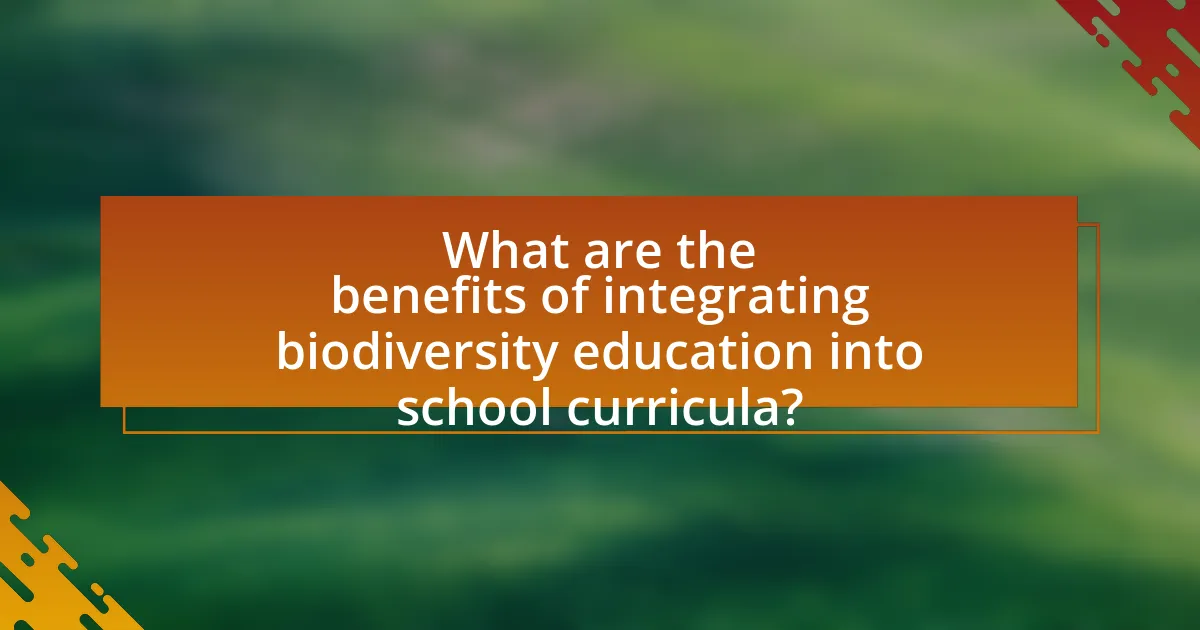
What are the benefits of integrating biodiversity education into school curricula?
Integrating biodiversity education into school curricula enhances students’ understanding of ecological systems and fosters environmental stewardship. This education promotes awareness of the importance of biodiversity for ecosystem health, which is crucial for sustaining life on Earth. Research indicates that students exposed to biodiversity concepts demonstrate improved critical thinking skills and a greater propensity to engage in conservation efforts. For instance, a study published in the Journal of Environmental Education found that students who participated in biodiversity-focused programs showed a 30% increase in their knowledge of local ecosystems and a 25% increase in their likelihood to participate in environmental activities. Thus, integrating biodiversity education not only enriches academic learning but also cultivates responsible future citizens.
How does biodiversity education impact student engagement?
Biodiversity education significantly enhances student engagement by fostering a deeper connection to the environment and promoting active learning. Research indicates that when students participate in hands-on biodiversity projects, such as field studies or conservation efforts, their interest and motivation in learning increase. For instance, a study published in the Journal of Biological Education found that students involved in biodiversity-related activities showed a 30% increase in engagement levels compared to traditional classroom settings. This engagement is further supported by the development of critical thinking and problem-solving skills as students explore real-world ecological issues, making the learning experience more relevant and impactful.
What skills do students develop through biodiversity education?
Students develop critical thinking, problem-solving, and teamwork skills through biodiversity education. Engaging with biodiversity topics encourages students to analyze complex ecological systems, evaluate human impacts, and devise solutions for environmental challenges. Research indicates that hands-on activities, such as field studies and collaborative projects, enhance these skills by fostering inquiry-based learning and promoting active participation in conservation efforts. For instance, a study published in the Journal of Biological Education highlights that students involved in biodiversity projects demonstrate improved analytical abilities and greater environmental awareness, reinforcing the effectiveness of biodiversity education in skill development.
How does biodiversity education foster critical thinking?
Biodiversity education fosters critical thinking by encouraging students to analyze complex ecological systems and their interdependencies. This educational approach promotes inquiry-based learning, where students engage in problem-solving and evaluate the impacts of human activities on ecosystems. Research indicates that when students explore real-world biodiversity issues, such as habitat loss or species extinction, they develop skills in reasoning, argumentation, and evidence-based decision-making. For instance, a study published in the Journal of Biological Education found that students who participated in biodiversity-focused projects demonstrated enhanced critical thinking abilities compared to those who did not engage in such activities.
What role do community partnerships play in biodiversity education?
Community partnerships play a crucial role in biodiversity education by enhancing resource availability and fostering collaborative learning experiences. These partnerships often involve local organizations, government agencies, and educational institutions that work together to provide students with hands-on opportunities to engage with their local ecosystems. For instance, studies have shown that schools collaborating with environmental organizations can access expert knowledge and resources, leading to more effective educational programs. Additionally, community partnerships facilitate real-world applications of biodiversity concepts, allowing students to participate in conservation projects, which has been linked to increased environmental stewardship and awareness among youth.
How can local organizations contribute to biodiversity curricula?
Local organizations can contribute to biodiversity curricula by providing resources, expertise, and hands-on experiences that enhance educational content. These organizations often have access to local biodiversity data, which can be integrated into lessons to make them more relevant and engaging for students. For example, organizations like conservation groups can offer field trips, workshops, and guest lectures that allow students to learn directly from experts in the field. Research indicates that experiential learning significantly improves student understanding and retention of complex topics, such as biodiversity. Additionally, local organizations can collaborate with schools to develop tailored curricula that reflect the unique ecological characteristics of the region, ensuring that students gain a deeper appreciation for their local environment.
What are examples of successful community collaborations?
Successful community collaborations in integrating biodiversity education into school curricula include the partnership between the National Wildlife Federation and various schools, which has led to the development of outdoor classrooms that enhance student engagement with local ecosystems. Another example is the collaboration between the California Academy of Sciences and local schools, where educators and scientists work together to create hands-on biodiversity projects, fostering a deeper understanding of environmental science among students. Additionally, the “Green Schools” initiative in New York City exemplifies successful community collaboration by involving parents, teachers, and local organizations to promote sustainability and biodiversity education within the school system. These collaborations demonstrate effective strategies for enhancing biodiversity education through community involvement and resource sharing.
What are some best practices for educators in implementing biodiversity education?
Best practices for educators in implementing biodiversity education include integrating hands-on, experiential learning opportunities, such as field trips to local ecosystems, which enhance student engagement and understanding. Research shows that experiential learning can improve retention of ecological concepts by up to 75%. Additionally, educators should incorporate interdisciplinary approaches, linking biodiversity topics to subjects like science, geography, and art, fostering a holistic understanding of the environment. Utilizing local biodiversity as a context for lessons makes the content more relevant and relatable, as studies indicate that place-based education increases student motivation and connection to their community. Finally, collaboration with local conservation organizations can provide resources and expertise, enriching the educational experience and promoting active citizenship among students.
How can teachers assess student understanding of biodiversity concepts?
Teachers can assess student understanding of biodiversity concepts through a variety of methods, including formative assessments, project-based learning, and standardized tests. Formative assessments, such as quizzes and class discussions, allow teachers to gauge students’ grasp of key concepts in real-time. Project-based learning, where students engage in hands-on activities like creating ecosystems or conducting field studies, provides deeper insights into their comprehension and application of biodiversity principles. Standardized tests can also measure understanding through specific questions related to biodiversity, ensuring that students can recall and apply their knowledge effectively. These assessment methods are supported by educational research indicating that active engagement and varied assessment types enhance student learning outcomes in complex subjects like biodiversity.
What resources can educators utilize for continuous improvement in biodiversity education?
Educators can utilize a variety of resources for continuous improvement in biodiversity education, including online platforms, professional development workshops, and community partnerships. Online platforms such as the National Geographic Education website provide lesson plans, interactive activities, and multimedia resources that enhance biodiversity understanding. Professional development workshops, like those offered by the North American Association for Environmental Education, equip educators with the latest teaching strategies and scientific knowledge. Additionally, community partnerships with local environmental organizations can provide hands-on experiences and real-world applications of biodiversity concepts, fostering deeper engagement and understanding among students.
